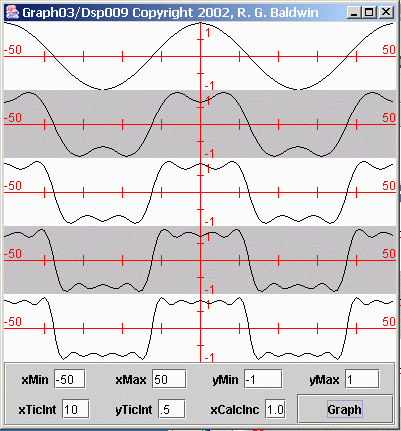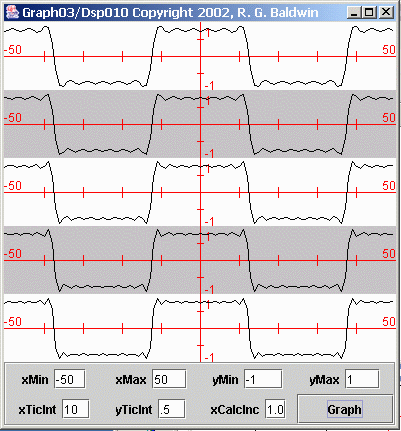| << Chapter < Page | Chapter >> Page > |
If you think of x as being a measurement of time in seconds, and 1/n being a measurement of frequency in cycles/second, the arguments to the sine and cosine functions can be viewed as:
2*pi(radians/cycle)*(x sec)*(1/n)( cycle/sec)
If you cancel out like terms, this reduces to:
2*pi(radians)*(x )*(1/n )
Thus, with a fixed value of n , for each value of x , the argument represents an angle in radians, which is what is required for use withthe functions of the Java Math library.
The value of the sine of an angle goes through zero at every integer multiple of pi radians. This explanation will probably make more sense if you refer back to Figure 3 .
The curve in Figure 3 was calculated and plotted for n equal to 50. The sine curve has a zero crossing for every value of x such that x is a multiple of n/2, or 25.
Similarly, the peaks in the cosine curve in Figure 3 occur for every value of x such that x is a multiple of n/2, or 25.
In theory, it is possible to decompose any time series into a number (quite possibly a very large number) of sine and cosine functions each having its own amplitude and frequency. (In a future module, we will learn how this is possible using a Fourier series or a Fourier transform.)
Conversely, it is theoretically possible to create any time series by adding together just the right combination of sine and cosine functions, each havingits own amplitude and frequency.
As an example of composition, suppose that I need to create a time series that approximates a square waveform, as shown at the bottom of Figure 6 .
| Figure 5. An approximate square waveform. |
|---|
 |
I can create such a waveform by adding together the correct combination of sinusoids, each having its own frequency and amplitude.
| Figure 6. An improved approximate square waveform. |
|---|
 |
The ten curves plotted in Figure 5 and Figure 6 show successive approximations to the creation of the desired square waveform. The bottom curvein Figure 6 is a plot of the following sinusoidal expression containing the algebraic sum of ten sinusoidal terms.
cos(2*pi*x/50)
- cos(2*pi*x*3/50)/3+ cos(2*pi*x*5/50)/5
- cos(2*pi*x*7/50)/7+ cos(2*pi*x*9/50)/9
- cos(2*pi*x*11/50)/11+ cos(2*pi*x*13/50)/13
- cos(2*pi*x*15/50)/15+ cos(2*pi*x*17/50)/17
- cos(2*pi*x*19/50)/19
The top curve in Figure 5 is a plot of only the first sinusoidal term shown above. It is a pure cosine curve.
Each successive plot, moving down the page in Figure 5 and Figure 6 adds another term to the expression being plotted, until all ten terms are includedin the bottom curve in Figure 6 .
As you can see, the bottom curve in Figure 6 is a reasonably good approximation to a square wave, but it is not perfect.
(A perfect square wave would have square corners, a flat top, no ripple, and perfectly vertical sides.)
If you start at the top of Figure 5 and examine the successive curves, you will see that the approximation to a square wave improves as each new sinusoidalterm is added.

Notification Switch
Would you like to follow the 'Digital signal processing - dsp' conversation and receive update notifications?